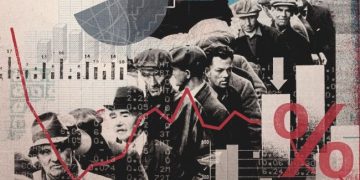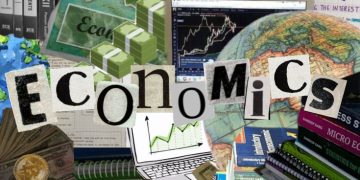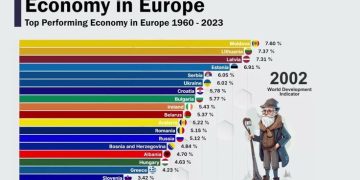U.S. trade policies have a profound impact on global economic dynamics, shaping relationships between countries, influencing supply chains, and guiding investment strategies. These policies, crafted and implemented by the U.S. government, are a critical factor in determining the course of international trade and economic growth. As the largest economy in the world and a major player in global markets, U.S. trade policies impact not only direct trading partners but also developing countries, multinational corporations, and global investors. This article delves into how changing U.S. trade policies affect global economic dynamics, particularly in developing nations, and explores the reshaping of global supply chains through trade agreements between the U.S., Europe, and China. It will also examine how investors can adjust their global investment strategies to accommodate these shifts.
The Impact of Changing U.S. Trade Policies on Global Economic Dynamics, Particularly in Developing Countries
U.S. trade policies have long been a central pillar of the global economic system. Over the decades, these policies have evolved, influenced by changing political leadership, economic priorities, and global events. The impact of these shifts is particularly profound in developing countries, where trade with the U.S. often represents a crucial economic lifeline.
1. Tariffs and Trade Barriers
One of the most immediate effects of changing U.S. trade policies has been the imposition of tariffs and trade barriers. These measures, often aimed at protecting domestic industries or addressing trade imbalances, can have far-reaching consequences for developing nations. For instance, under the leadership of President Donald Trump, the U.S. imposed tariffs on hundreds of billions of dollars’ worth of goods from China, Europe, and other countries, creating a ripple effect that impacted global markets, including those in developing economies.
When tariffs are imposed on products imported from developing countries, it can lead to a decrease in demand for those countries’ goods in the U.S. market. This directly impacts their economies, as they may rely heavily on exports to the U.S. for growth. For instance, countries in Latin America and Africa that export commodities such as agricultural products, textiles, and natural resources could experience a slowdown in export revenues. Furthermore, these countries may face difficulties in diversifying their export markets, especially if they are already heavily dependent on the U.S.
2. Supply Chain Disruptions
The impact of changing U.S. trade policies extends beyond tariffs. U.S. trade policies often lead to disruptions in global supply chains, which can have significant consequences for developing countries. As companies seek to navigate shifting trade landscapes, they may move manufacturing operations or change suppliers in response to tariffs or regulatory changes.
For instance, during the U.S.-China trade war, many companies sought to relocate manufacturing away from China to avoid tariffs on Chinese-made goods. While some of this production shifted to other countries in Asia, such as Vietnam or Thailand, others moved to developing nations outside of Asia altogether. These shifts can create opportunities for developing countries to attract investment in manufacturing and trade, but they can also lead to job losses in countries that lose out in the reconfiguration of supply chains.
For developing countries that rely on a single sector or export market, such as textiles or electronics, the fallout from disrupted supply chains can be especially challenging. Shifts in production can lead to higher unemployment, lower wages, and reduced economic growth.
3. Foreign Aid and Trade Preferences
U.S. trade policies also influence foreign aid and trade preferences extended to developing countries. Through programs like the African Growth and Opportunity Act (AGOA) and the Generalized System of Preferences (GSP), the U.S. offers trade benefits to certain developing countries. These policies grant duty-free access to the U.S. market for specific products, which can be an important source of revenue for these countries.
However, changing U.S. trade policies, such as the potential withdrawal of trade preferences or the introduction of new trade conditions, can affect developing countries’ access to U.S. markets. The loss of such trade privileges can lead to a decrease in exports and foreign investment, thus slowing down economic growth in these countries.
How Trade Agreements Between the U.S., Europe, and China Are Reshaping Global Supply Chains
Trade agreements between the U.S., Europe, and China play a crucial role in shaping global supply chains and economic relationships. As the global economy becomes increasingly interconnected, these agreements often serve as a framework for how goods and services flow between regions, with far-reaching consequences for businesses, governments, and investors worldwide.
1. The U.S.-China Trade Relationship
The U.S.-China trade relationship is perhaps the most significant factor reshaping global supply chains in recent years. As the world’s two largest economies, the U.S. and China account for a significant portion of global trade and economic activity. Changes in their trade policies, particularly regarding tariffs and trade barriers, can significantly alter the course of global supply chains.
During the U.S.-China trade war (2018-2020), both countries imposed tariffs on each other’s goods, disrupting the flow of trade and affecting businesses around the world. In response to these tensions, companies began looking to shift production out of China to avoid high tariffs on Chinese-made goods. Countries in Southeast Asia, such as Vietnam and Thailand, saw increased investment in manufacturing as companies sought alternatives to Chinese factories.
Trade agreements like the Phase One trade deal between the U.S. and China, signed in January 2020, aimed to ease some of the tensions and restore normalcy to the trade relationship. However, despite this agreement, the broader issue of trade imbalances and intellectual property rights continues to influence global supply chains and investment patterns.

2. U.S.-European Union Trade Relations
The U.S.-European Union (EU) trade relationship is another key factor influencing global supply chains. Historically, the U.S. and the EU have maintained a strong economic partnership, with the EU being one of the largest trading blocs in the world. However, recent trade disputes, particularly under President Trump’s administration, have put this relationship under strain. The imposition of tariffs on European goods, such as steel and aluminum, as well as the trade tensions related to the Airbus-Boeing dispute, have complicated trade relations between the two regions.
While the Biden administration has sought to ease some of these tensions, trade policies between the U.S. and the EU still play a pivotal role in determining the future of global supply chains. If the U.S. and the EU can reach new trade agreements, it could lead to the creation of more streamlined and efficient supply chains between the two regions, potentially benefiting global businesses and investors.
3. Regional Comprehensive Economic Partnership (RCEP) and China’s Role
In the broader context of U.S.-China trade relations, the creation of the Regional Comprehensive Economic Partnership (RCEP) is another crucial development. Signed in November 2020, RCEP is a trade agreement between China, Japan, South Korea, and 14 other Asia-Pacific countries, making it the world’s largest free trade area. This agreement is reshaping the region’s supply chains, particularly in the manufacturing sector.
RCEP strengthens China’s role as a central hub in global supply chains, particularly in East Asia. As a result, companies in the U.S. and Europe that rely on Asian manufacturing may find themselves adjusting their supply chain strategies to account for new trade dynamics in the region. This could lead to shifts in production sites and supply sources, affecting global trade flows.
How Investors Can Adjust Global Investment Strategies to Accommodate U.S. Trade Policies
The evolving landscape of U.S. trade policies presents both challenges and opportunities for investors. As trade relationships shift and global supply chains are reconfigured, investors need to adapt their strategies to account for these changes. Here are some key approaches that investors can take to navigate the impact of U.S. trade policies on global markets.
1. Diversification of Investment Portfolios
Given the potential for disruptions in global trade flows, it is essential for investors to diversify their portfolios across different sectors, regions, and asset classes. By investing in a variety of industries and countries, investors can reduce the risks associated with trade policy changes and mitigate the impact of supply chain disruptions. For instance, diversifying investments between emerging markets, developed economies, and industries like technology, healthcare, and manufacturing can help protect against the volatility of any single market or sector.
2. Investing in Trade-Resilient Industries
Certain industries are more resilient to the effects of trade policy changes than others. For instance, technology companies that rely on global supply chains may be better positioned to navigate shifts in trade relationships, as their products often have high demand across borders. Similarly, companies that manufacture essential goods or those involved in the production of renewable energy may benefit from increasing global trade despite changing tariffs and trade restrictions.
Investors can also consider industries that are less reliant on international trade, such as domestic-focused businesses in the U.S. or Europe. These companies may be better insulated from the impact of changing trade policies and could offer more stable returns during times of uncertainty in global markets.
3. Tracking Trade Agreements and Regulatory Changes
Investors must stay informed about the latest trade agreements, tariffs, and regulatory changes that may affect their investments. By closely monitoring trade policies between the U.S., China, and Europe, as well as regional trade agreements like RCEP, investors can anticipate shifts in global supply chains and make informed decisions about where to allocate capital.
Investors can also focus on regions or countries that are emerging as key players in global trade. For example, countries that are part of trade agreements like RCEP or the U.S.-Mexico-Canada Agreement (USMCA) may experience growth in trade and investment, making them attractive targets for investment.
4. Currency Hedging
As trade policies change and the global economic landscape shifts, fluctuations in currency values can have a significant impact on international investments. Currency hedging strategies can help protect against adverse currency movements, ensuring that investors are not overly exposed to the risks of currency devaluation or appreciation in response to trade policy changes.
Conclusion
U.S. trade policies play a pivotal role in shaping global economic relationships and the way businesses, governments, and investors engage with each other. The impact of these policies is especially pronounced in developing countries, which are often more vulnerable to shifts in trade dynamics. Additionally, trade agreements between the U.S., Europe, and China are reshaping global supply chains, creating new opportunities and challenges for businesses and investors alike. To succeed in this ever-changing environment, investors must adapt their strategies to account for evolving trade relationships, diversification, and regional shifts in global trade patterns.





























